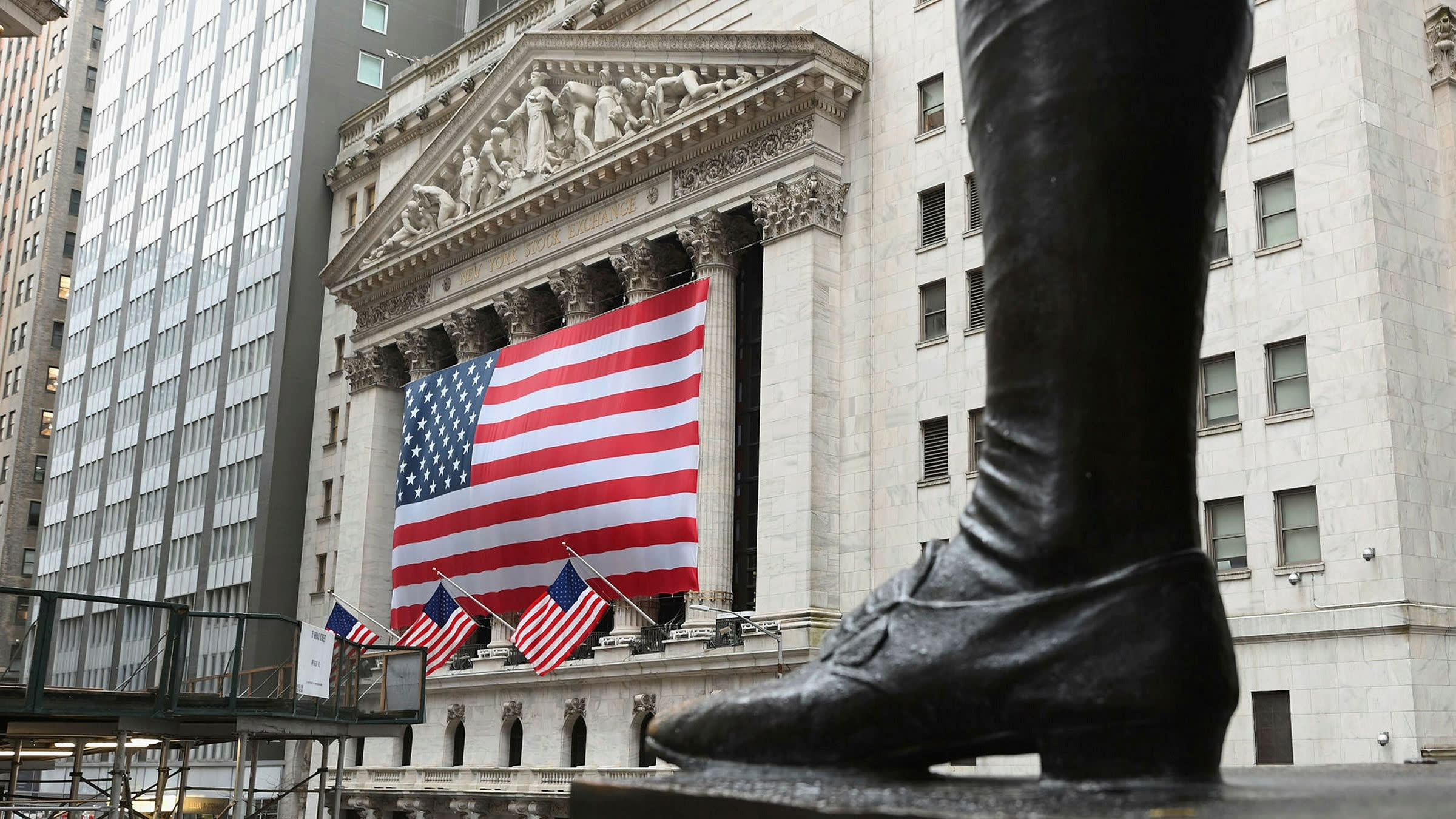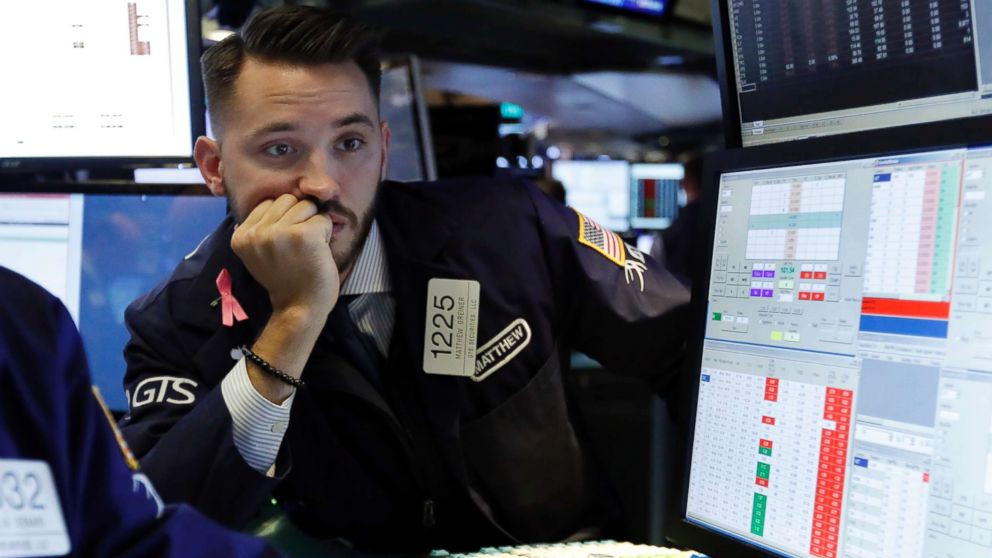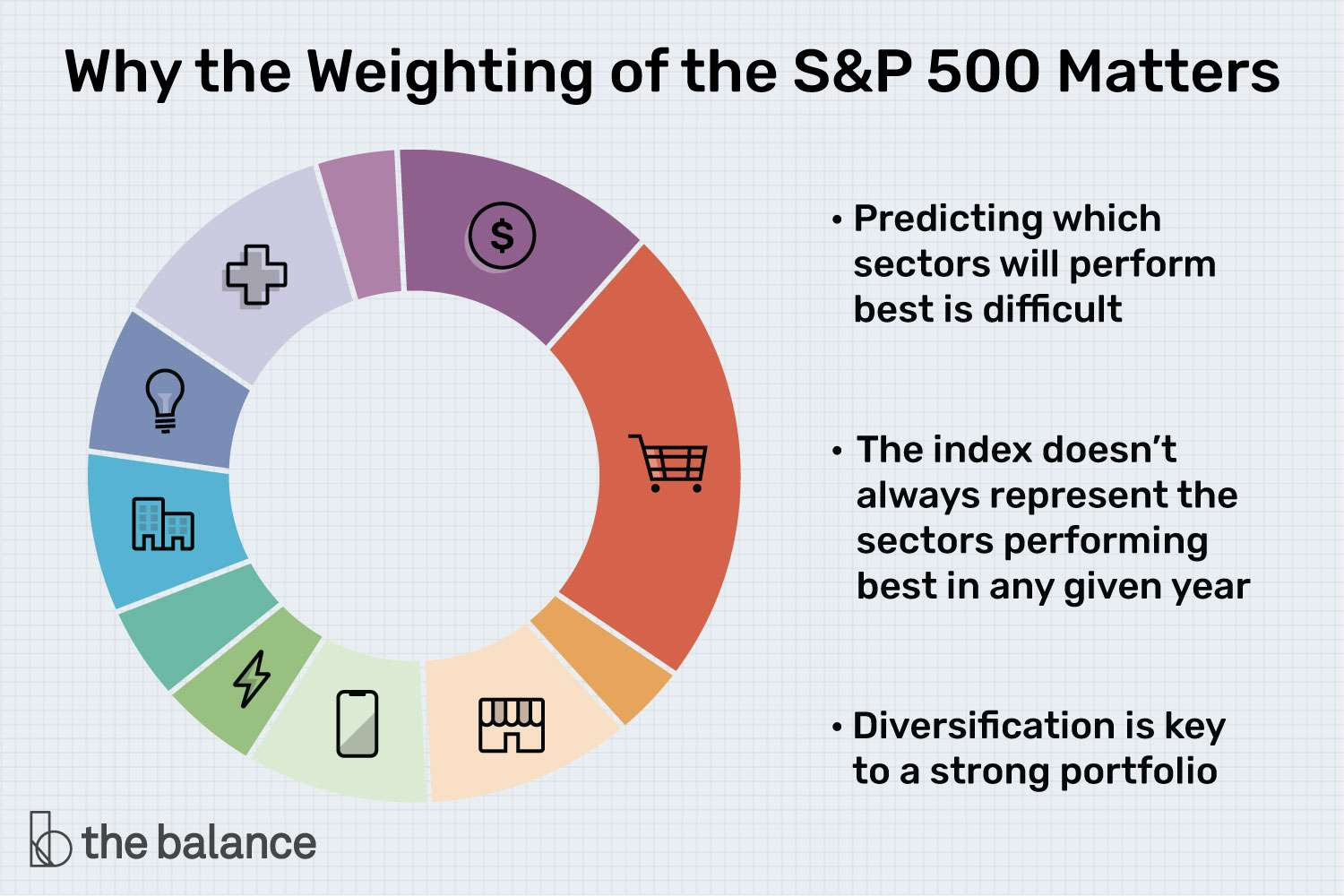Stocks fell sharply on Friday as a much weaker-than-anticipated jobs report for July ignited worries that the economy could be falling into a recession.
The broad market index dropped 1.84% to end at 5,346.56. The Nasdaq Composite lost 2.43% to close at 16,776.16, bringing the decline for the tech-heavy index from its recent all-time high to more than 10%. The Dow Jones Industrial Average fell 610.71 points, or 1.51%, to finish at 39,737.26. At its session low, the 30-stock index was down 989 points.
Stocks Sink on Dismal Jobs Data
Stocks sank after July job growth in the U.S. slowed more than expected, while the unemployment rate rose to the highest since October 2021. Nonfarm payrolls grew by just 114,000 last month, the Labor Department reported, a slowing from 179,000 jobs added in June and below the 185,000 expected by economists polled by Dow Jones. The unemployment rate increased to 4.3%.
Bonds Rally as Recession Fears Mount
Tech Stocks Lead the Sell-Off
Some megacap names saw steep losses during the day, as Amazon's second-quarter results sparked investor concerns about Big Tech's blowout levels of artificial intelligence-related capital spending. The e-commerce giant slid 8.8% after missing the Street's revenue estimates and issuing a disappointing forecast. Intel, meanwhile, cratered 26% after announcing weak guidance and layoffs. Nvidia lost 1.8%, following a 6% loss a day before.
Nasdaq Enters Correction Territory
The Nasdaq is the first of the three major benchmarks to enter correction territory, down more than 10% from its record high. The S&P 500 and Dow were 5.7% and 3.9% below their all-time highs, respectively.
Bull Market Correction
Friday's declines are a "natural course" in a bull market that is reverting after its steep uptrend, LPL Financial chief technical strategist Adam Turnquist said.
"[The Nasdaq] was very overbought coming into July, same thing with semiconductors. And a lot of that AI enthusiasm hasn't really had a reality check at this stage," he said, adding that "it's not the end of the AI story."
Recession Fears Weigh on Bank Stocks
But it was more than just technology stocks that saw selling on Friday. Bank stocks were slammed on the recession fears with Bank of America off 4.9% and Wells Fargo down 6.4%.
Volatility Continues
It has been a volatile week with the S&P 500 moving more than 1% in each of the past three trading sessions. The stock market had rallied Wednesday when the Fed gave a strong hint that a rate cut was coming at its next meeting in September. After Friday's weak job figures, many investors are starting to believe the central bank should have acted on Wednesday.
Dow Drops Over 600 Points
Stocks extended their steep declines on Friday.
The Dow Jones Industrial Average dropped 610.71 points, or 1.51%, to finish at 39,737.26. The S&P 500 lost 1.84% to end at 5,346.56, while the Nasdaq Composite shed 2.43% to close at 16,776.16.
— Pia Singh
Sahm Rule Triggered
Though the numbers indicate the so-called Sahm Rule has been triggered, the developer of the indicator said the economy is not in recession.
"We are not in a recession now — contrary [to] the historical signal from the Sahm rule — but the momentum is in that direction," Claudia Sahm, chief economist at New Century Advisors, said via email. "A recession is not inevitable and there is substantial scope to reduce interest rates.
The rule states that when the unemployment rate over a three-month period averages half a percentage point above the 12-month low, the economy is in recession. The jobless rate rose to 4.3% in July, bringing the three-month average to more than 4.1%, compared to the 3.5% 12-month low.
However, Sahm said in a recent Substack post that the rule "is likely overstating the labor market's weakening due to unusual shifts in labor supply caused by the pandemic and immigration."
"The Sahm rule is currently sending the right cautionary message about the labor market cooling, but the volume is too loud," she added.
— Jeff Cox
Stocks to Ride Out Volatility
With the market selling off and the Nasdaq Composite entering correction territory on Friday, a collection of stocks could help investors ride out the volatility.
The CNBC Pro Stock Screener Tool turned up a handful of names with low volatility and a strong dividend return yield that could give investors a safe haven and still provide growth. The names on the list span behemoths in the fast-food industry as well as a premier defense contractor.
CNBC Pro subscribers can read the full story here. You can also check out the CNBC Pro Stock Screener Tool and customize your own screens.
— Brian Evans
Nervous Sentiment Drives Sell-Off
Friday's sell-off, which continues the market's losses on Thursday, indicates rising nervous sentiment among investors, according to Deutsche Bank.
The CBOE Volatility Index rose to its highest level since April, the firm noted. The challenges are not just isolated to the U.S. The Nikkei in Japan also declined nearly 5%, its worst day since 2022, head of global economics and thematic research Jim Reid wrote in a Friday note.
"The past 24 hours have seen an increasingly precarious backdrop for risk markets with a risk-off mood on the back of another batch of weak U.S. data yesterday followed by mostly downbeat tech earnings overnight," said Reid.
— Hakyung Kim
Fed Needs to Act
The Federal Reserve will have to do some damage control now that the labor market is showing signs of weakening, according to Byron Anderson, head of fixed income at Laffer Tengler Investments.
"The Fed narrative of data dependent should be done moving forward especially if the labor data continues to fall before the next Fed meeting," Anderson wrote. "The Fed will need to go into economic protection mode moving forward to calm markets."
"We should see rate cuts shortly and the bond market is asymmetrically positioned lower for the short term," Anderson continued.
— Sarah Min
Earnings Season Provides Little Upside
Equities could have a more difficult time capturing a goldilocks scenario as the second-quarter earnings season leaves little upside surprises, according to Morgan Stanley's Global Investment Committee.
"[T]he earnings season has produced limited positive surprises, with forecasts reflecting negative revisions breadth and hints of skepticism about returns on generative AI investments," Morgan Stanley Wealth Management Chief Investment Officer Lisa Shalett said. "The implication, once again, is market action pivoting almost exclusively on valuation multiples and thus the rates forecast."
"And it is here that the GIC is cautious," she added. "While a soft landing remains our base case, we recognize that the path to a 'Goldilocks' scenario is narrowing, with US consumers increasingly solely dependent on jobs for consumption."
— Brian Evans
Fed Should Have Cut Rates Earlier
Rick Rieder, BlackRock Chief Investment Officer of global fixed income, believes Friday's disappointing jobs report suggested that the Federal Reserve should have moved forward with a rate cut earlier this week.
"Today's data … in fact suggests that the Fed should have started cutting already as the Fed Funds rate at 5 3/8% is clearly too restrictive relative to inflation that is trending in the low 2's and with slack building in the labor force," he said in a note.
Rieder said the data showed "material" weakness in the labor market and marked the first clear sign of employment slowing across virtually every metric of the jobs report.
— Yun Li
Companies Making Headlines
Check out some of the companies making headlines:
Read the full list here.
— Brian Evans
Chevron Faces Delays
Chevron stock is down more than 3% this week after the oil major missed earnings estimates and faces delays to its pending acquisition of Hess Corporation.
Chevron's second-quarter earnings missed Wall Street expectations as the company faced headwinds from lower refining margins. The company announced it is relocating its headquarters from California to Texas.
The stock is also under pressure after Chevron disclosed Wednesday that an arbitration panel will not meet until May 2025 to hear the dispute with Exxon Mobil over Hess' lucrative oil assets in Guyana.
The arbitration is expected to issue a ruling around August or September. This means the Hess deal will not close until well into 2025. Chevron originally expected to complete the deal this year. If the arbitration panel rules in Exxon's favor, the Chevron-Hess deal will not close.
— Spencer Kimball
NYSE and Nasdaq Sell-Off
The percentage of shares and number of stocks falling on the New York Stock Exchange and Nasdaq are even worse Friday, in the wake of weaker-than-expected July jobs and June durable goods and factory order reports, than they were on Thursday.
Declining volume totaled 86% of all shares traded on the NYSE in early afternoon trading, and 78% on the Nasdaq, according to FactSet data. The number of declining stocks on the NYSE totaled 76% against 75% on Nasdaq.
Still, because the market has been so strong recently, scoring new all-time highs as recently as last month, the number of new 52-week highs on the NYSE reached 145 versus 118 new lows, while on Nasdaq, new lows swamped new highs 311 to 110.
Early afternoon composite volume on both markets was above average, especially for a Friday afternoon in August, surpassing 70% of the past 30 days' daily average on each exchange.
— Scott Schnipper
Fear Gauge Surges
During Friday's sell-off, the CBOE Volatility Index leapt as high as 29.66.
That marked the highest level for Wall Street's "fear gauge" since March 15, 2023, when it leapt to 29.91.
As of 12:30 p.m. ET, the so-called VIX index came off its highs to trade at roughly 26.
The VIX index tracks the 30-day expected volatility of the stock market, based on the pricing of S&P 500 options.
— Darla Mercado, Chris Hayes, Nick Wells
Sun Country Shifts Focus to Amazon
Shares in Amazon air freight contractor Sun Country were up close to 1% in afternoon trading, one of the few airline stocks trading higher on Friday, after the carrier outlined bigger emphasis on flying for the retail giant. That will shift growth away from an oversupplied domestic market that has depressed airfare and pushed down airline profits.
The low-cost carrier that is mostly focused on leisure travelers last month said it has a deal with Amazon to increase flying with Amazon to 20 freighters from 12, a deal that Sun Country said will improve earnings, and prompt it to scale back flying passengers early next year.
"As new Amazon aircraft come into service starting in late-first quarter 2025, we intend to moderately shrink our scheduled service business to accommodate the Amazon growth," the airline said in an earnings release. "Our intent is to begin growing the scheduled service business again in 2026.
Sun Country turned a $1.8 million profit for the second quarter, down more than 91% for the quarter. Similar to other carriers, it plans to slow passenger flight growth in the third quarter compared to earlier this year.
— Leslie Josephs
Oil Prices Tumble
U.S. crude oil tumbled more than 3% to its lowest level since early June.
The West Texas Intermediate contract for September dropped $2.49, or 3.26%, to $73.82 per barrel. The October Brent contract tumbled $2.38, down 2.99%, to $77.22 per barrel.
WTI is down 4.26% this week while the global benchmark is down 4.8%.
Oil had rallied earlier in the week after the assassination of Hamas leader Ismail Haniyeh in Tehran, raising fears that Israel and Iran are moving closer to war.
But the war risk premium has largely evaporated as growing fears that the U.S. is heading toward a recession has raised concerns about future demand.
— Spencer Kimball
August Slump for Stocks
August may have just began, but it has not been a good month so far for the major averages.
The S&P 500 was last down 4% on the month, while the Dow Jones Industrial Average shed 3.6%. The Nasdaq Composite was also on pace for a 5.1% decline in August.
The Russell 2000 ended July 10.1% higher, beating all three major averages. However, it is so far slated to close August 7.1% lower.
— Lisa Kailai Han
Bitcoin Bucks Trend
Bitcoin traded in the green on Friday amid the broader sell-off in risk assets.
The price of the flagship cryptocurrency was last higher by 0.6% at $63,703.02, according to Coin Metrics. Other cryptocurrencies fell. Crypto stocks Coinbase and MicroStrategy lost 4% and 2%, respectively.
Bitcoin's correlation with the Nasdaq Composite has been rolling back in recent days, while its gold correlation has increased.
Earlier in the day, bitcoin rose as much as $65,563.40, but trimmed that gain as the sell-off in stocks accelerated mid-morning.
— Tanaya Macheel
VIX Surges on Fears
The Cboe Volatility Index, known as the VIX, surged about 3 points to 21.51, hitting the highest level since Oct. 27.
The VIX tracks the 30-day implied volatility of the S&P 500 and looks at prices of options on the S&P 500 to track the level of fear on Wall Street.
— Yun Li
Fed Rate Cut Odds Rise
The odds of the Federal Reserve slashing its benchmark overnight lending rate a half a percentage point — to 4.75% to 5.00% from today's 5.25% to 5.50% — at its next policy meeting in mid-September soared Friday on the Chicago Mercantile Exchange in reaction to July's weaker-than-expected jobs report. One basis point equals one one hundredth of a percent, or 0.01%.
Traders in 30-day fed funds interest rate futures now assign a 61.5% chance of the central bank cutting borrowing rates by 50 basis points, up from only a 22% chance on Thursday, 11.5% odds a week ago and a scant 5.5% possibility one month ago.
Conversely, the odds of only a quarter-point reduction in the fed funds rate in September tumbled to 38.5% Friday morning from 78% on Thursday, 88.2% one week ago and 63.4% one month ago, according to the CME FedWatch Tool.
By the Fed's last policy meeting of the year on Dec. 18, traders are now assigning a 44.4% probability that the fed funds rate will stand a full percentage point below today's level, at 4.25% to 4.50%. The odds that fed funds will fall all the way to 4.00% to 4.25% by the end of the year have suddenly jumped to 34.2% Friday from just 2.6% Thursday.
— Scott Schnipper
Stocks Open Lower
The S&P 500 opened 1.4% lower shortly after 9:30 a.m. ET. The tech-heavy Nasdaq Composite slid 2.4%, while the Dow Jones Industrial Average dropped 345 points, or 0.9%.
— Pia Singh
Jobs Report Fuels Recession Fears
The U.S. economy added far fewer jobs than anticipated, adding to worries over the state of the economy. In July, 114,000 jobs were created. Economists polled by Dow Jones expected an increase of 185,000 jobs last month.
The unemployment rate also rose to 4.3%.
— Fred Imbert
Companies Making Headlines Pre-Market
Check out the companies making headlines before the bell:
The full list can be found here.
— Hakyung Kim
Exxon Mobil Beats Estimates
Exxon Mobil reported a stronger-than-expected profit for the second quarter amid record production in Guyana and the Permian Basin. Earnings per share came in at $2.14, beating an LSEG forecast of $2.01 per share.
Shares were down slightly in the premarket.
— Fred Imbert
Intel Suffers Worst One-Day Pullback
Intel's latest quarterly report did little to assuage concerns over the chipmaker's future.
Shares dropped 20% in premarket trading — which would mark their worst one-day pullback since 2000 — on the back of weaker-than-expected earnings and revenue for the second quarter. The company also announced it would lay off more than 15% of employees due to a $10 billion cost-cutting push.
— Fred Imbert
Nikkei Suffers Biggest Sell-Off
The Japanese Nikkei 225 suffered a 5.8% drop in overnight trading — its biggest one-day sell-off since March 2020 — as Thursday's pullback on Wall Street sent shockwaves around the global market. The index also fell below 36,000 for the first time since January.
— Fred Imbert
Jobs Report in Focus
Traders are eyeing a key economic report that is sure to shape Friday's action: the July jobs report.
The Labor Department's Bureau of Labor Statistics is set to issue the nonfarm payrolls report at 8:30 a.m. ET. Economists polled by Dow Jones anticipate that employers added 185,000 positions in July. They also expect the unemployment rate to hold steady at 4.1%.
Average hourly wages are also on the minds of investors, with economists anticipating wages rose on a monthly basis by 0.3% in July and grew 3.7% over the past 12 months.
The report comes out at a time when a raft of soft economic data reawakened traders' fears of an approaching recession. Those worries cued a sharp sell-off on Thursday.
Get the details from CNBC's Jeff Cox on what to watch in the July jobs report here.
— Darla Mercado
Utilities Hold Strong
It has been a rough week for stocks, with the S&P 500 on pace for a decline of 0.2%, but the utilities have been holding up well against the storm.
Seven of the 11 S&P 500 sectors are on track to end the week in positive territory, with utilities leading the pack. Utilities, once a sleepy corner of the stock market, are up 4.15% for the week. They also held their ground as investors panicked over recession risk on Thursday. The sector wrangled a 1.85% gain even as the major averages tumbled.
Utility stocks leading the way for the week include Vistra, on pace for a pop of nearly 7%, and Southern Company, up about 6.6% for the period.
— Darla Mercado, Chris Hayes
Companies Making Headlines After Hours
Check out the companies making headlines in extended trading:
The full list can be found here.
— Hakyung Kim
Futures Point to Lower Open
U.S. stock futures were lower Thursday night.
S&P 500 futures fell 0.2%. Futures tied to the Dow Jones Industrial Average lost 96 points, or 0.2%, and Nasdaq 100 futures dropped 0.3%.
— Hakyung Kim
Got a Tip?
Got a confidential news tip? We want to hear from you.
Sign up for free newsletters and get more CNBC delivered to your inbox
Get this delivered to your inbox, and more info about our products and services.
© 2024 CNBC LLC. All Rights Reserved. A Division of NBCUniversal
Data Disclaimer
Data is a real-time snapshot *Data is delayed at least 15 minutes. Global Business and Financial News, Stock Quotes, and Market Data and Analysis.
Data Providers
Data also provided by


















